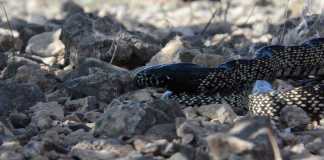Would you let a 14-month old baby play around with one of the five largest snakes in the world? Well maybe after you watch this awe-inspiring video, you will…
Snake handler Jamie Guarino is raising his daughters with snakes for years already. When his daughter Alyssa was only 14 month old, Gaurino filmed her at their home in Michigan, having the time of her life playing with a 13-foot-long Burmese Python (Python bivittatus). His menu is usually made up of appropriately sized birds and mammals, as it uses his sharp teeth to seize his prey, wrapping his body around it, while contracting its muscles, constricting and suffocating it to death. Amazingly, these giant reptiles have become extremely popular snake pets due to their beautiful colors and easy-going nature.
Gaurino claims he is raising his kids with exotic pets in order to open the minds of children to something different. He tries to show the world that these wonderful reptiles are not dangerous as most believe. Many people watching the video reacted with fear, saying to themselves that the python might swallow such a baby alive. However, Gaurino claims the Burmese Python has no desire to bite or swallow the baby, and you can actually see that in the video. Despite their bad reputation, Burmese Pythons “can be a loving pet”, he says. Gaurino’s dream is to open a reptile zoo together with his daughters.

About the Burmese Python
This giant reptile has a rapid growth rate, and can average 12 ft (3.7 meters) in the wild, although there are records of Burmese pythons that reached 19 ft (5.7 ft). They are good climbers, but more than that – excellent swimmers who are usually found near water. They can be found in swamps, woodlands, marshes, jungles or grasslands, and are native to the tropic and subtropic regions of Southern and South-east Asia. However, Burmese Pythons have practically invaded other areas of the World.
In South Florida, scientists believe the invasion of Burmese pythons originated with snake owners who started to release their snake pets into the Everglades National Park. It is quite a remarkable situation, where the Burmese python is declining in its native habitat in Asia and is considered by the IUCN as “Vulnerable”, while the numbers of the giant snake in Florida are increasing dramatically. The reason: It has practically no predators in Florida, and are therefore it is becoming a threat to various animals, such as birds, coyotes and even the Florida panthers. The number of Burmese pythons in the area has reached the required minimum to classify it as an “invasive species”.
Watch this video about the issue:
Want to help solve the issue?
In 2008, The Nature Conservancy in Florida launched the Python Patrol, which trained over 400 responders to deal directly with the situation by safely and humanely capturing and removing pythons or other exotic constrictors they encounter.
Citizens can learn how to identify pythons and other non-native animals at an in-person detector training or online. Anyone can call in snake sightings (1-888-IVE-GOT-1) to the Florida Fish and Wildlife Conservation Commission, which now coordinates Python Patrol, and a trained responder can be dispatched.


